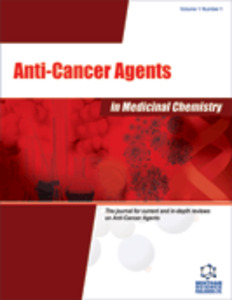Please use this identifier to cite or link to this item:
https://repositorio.uca.edu.ar/handle/123456789/15249| Título: | Hepato and cardiotoxicity of chemotherapeutic treatment evaluated by means of small animal imaging | Autor: | Tesan, Fiorella Carla Portillo, Mariano Gaston Martinel Lamas, Diego José Medina, Vanina Araceli Salgueiro, Maria Jimena Zubillaga, Marcela Beatriz |
Palabras clave: | HISTAMINA; ESTRUCTURA MOLECULAR; DOXORRUBICINA; HIGADO; CORAZON | Fecha de publicación: | 2017 | Editorial: | Bentham Science | Cita: | Tesan, F.C., et al. Hepato and cardiotoxicity of chemotherapeutic treatment evaluated by means of small animal imaging [en línea]. Anti-Cancer Agents in Medicinal Chemistry. 2017, 17(3) doi:10.2174/1871520616666151110130619 Disponible en: https://repositorio.uca.edu.ar/handle/123456789/15249 | Resumen: | Abstract: Background: Chemotherapy is one of the most common approaches for cancer treatment. Particularly Doxorubicin has been proven to be effective in the treatment of many soft and solid tumors for locally advanced and metastatic cancer. It is not easy to clinically evaluate the chemotoxic or chemoprotective effect of some drugs, even more when there is a subclinical toxicity. Objective: To determine the usefulness of the hepatobiliary, colloid and cardiac scintigraphies, employing 99mTcdisida, 99mTc-phytate and 99mTc-sestamibi respectively, in the evaluation of the hepato and cardiotoxicity of two chemotherapeutic treatments assessed in rats. Method: Two groups were submitted to doxorubicin (DOX) treatment and one was co-administered with histamine (DOX+HIS). Static 99mTc-phytate and 99mTc-sestamibi scintigraphies as well as a dynamic 99mTc-disida study were performed in a small field of view gamma camera at: 0 weeks (control), 1 week and 2 weeks of treatment. Imagenological parameters were calculated: Liver/Bone Marrow ratio (L/BM), Heart/Background ratio (H/B) and time to the maximum (Tmax) for 99mTc-phytate, 99mTc-sestamibi and 99mTc-disida extraction, respectively. Results: Control (L/BM= 98±3; H/B=2.3±0.4; Tmax=8±3), DOX (L/BM: 85±3, 80±3; H/B, 3.5±0.5, 3.3±0.5 and Tmax 6±1, 4±1) for 1 and 2 weeks respectively and DOX+HIS (L/BM: 99±0.3, 98±1; H/B 2.9±0.5, 2.9±0.5 and Tmax, 8±2, 9±2) for 1 and 2 weeks, respectively. Histological analysis showed cardio and hepatotoxicity induced by doxorubicin. Conclusion: Imagenological parameters showed differences among treated and control groups and between both chemotherapy treatments. Thus, these radiopharmaceutical functional approaches were able to reflect heart and liver toxicity produced by doxorubicin. | URI: | https://repositorio.uca.edu.ar/handle/123456789/15249 | ISSN: | 1871-5206 1875-5992 (online) |
Disciplina: | MEDICINA | DOI: | 10.2174/1871520616666151110130619 | Derechos: | info:eu-repo/semantics/closedAccess | Fuente: | Anti-Cancer Agents in Medicinal Chemistry. 2017, 17(3) |
| Appears in Collections: | Artículos |
Files in This Item:
| File | Description | Size | Format | |
|---|---|---|---|---|
| thumb.gif | 9,92 kB | GIF |  View/Open | |
| hepato-cardiotoxicity.pdf | 5,37 MB | Adobe PDF | Request a copy |
Page view(s)
63
checked on Apr 27, 2024
Download(s)
15
checked on Apr 27, 2024
Google ScholarTM
Check
Altmetric
Altmetric
This item is licensed under a Creative Commons License

